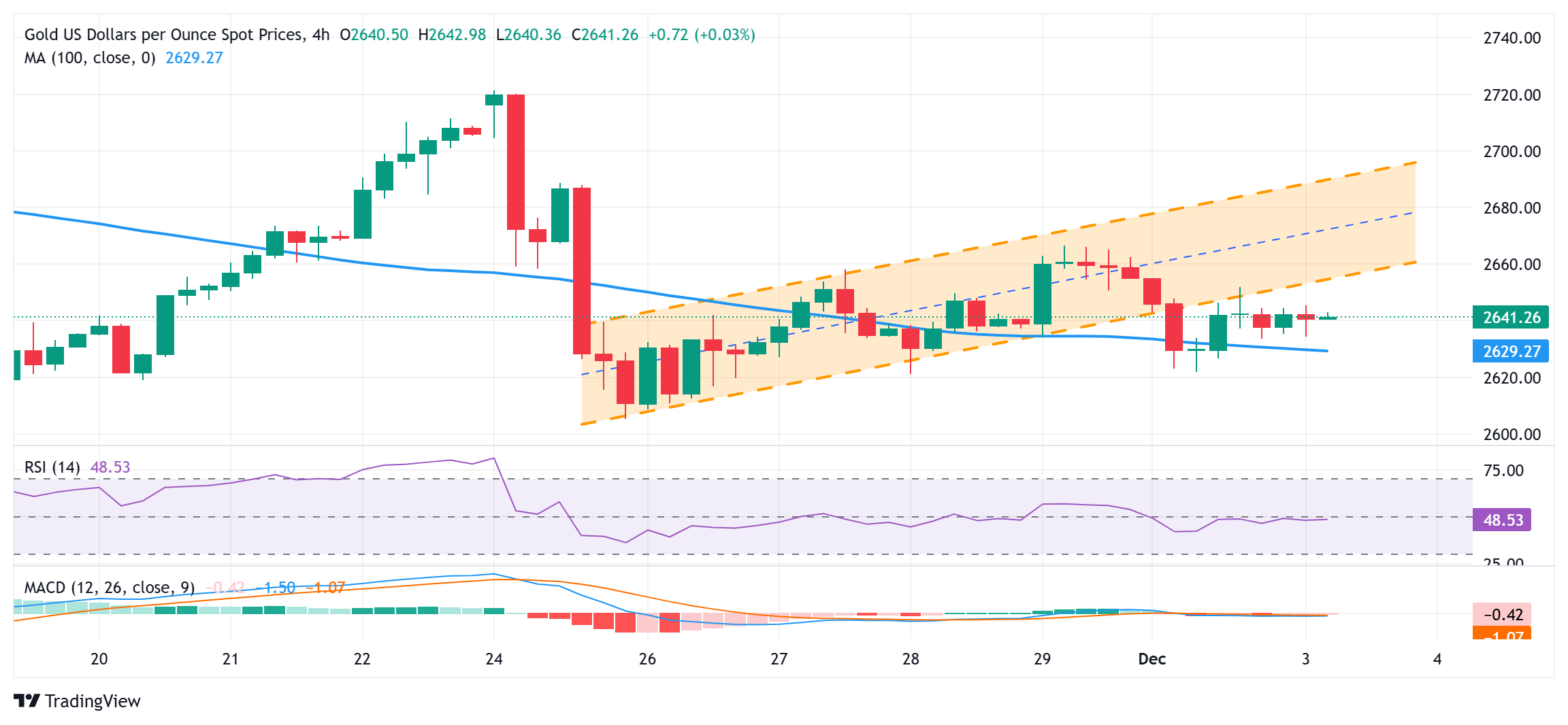Gold flat lines below $2,650 level amid mixed fundamental cues

- Gold price lacks a firm direction and is influenced by a combination of diverging forces.
- Bets for a less dovish Fed underpin the USD and act as a headwind for the XAU/USD.
- Trade war fears, geopolitical risks and depressed US bond yields offer some support.
Gold price (XAU/USD) struggles to capitalize on the previous day’s rebound from the $2,620 region and oscillates in a narrow band during the Asian session on Tuesday. Expectations for a less dovish Federal Reserve (Fed) assist the US Dollar (USD) to attract some follow-through buying and turn out to be a key factor acting as a headwind for the non-yielding yellow metal. That said, concerns about US President-elect Donald Trump’s tariff plans, persistent geopolitical uncertainty and suppressed US Treasury bond yields offer some support to the commodity.
Traders also seem reluctant and opt to wait for more cues about the Fed’s rate-cut path before positioning for the next leg of a directional move for the Gold price. Hence, the market focus will remain glued to this week’s important US macro releases, including the Nonfarm Payrolls (NFP) report on Friday. Apart from this, Fed Chair Jerome Powell’s speech will be looked upon for the interest rate outlook in the US. This, in turn, will play a key role in influencing the near-term USD price dynamics and providing some meaningful impetus to the XAU/USD.
Gold price traders await Fed rate cut cuts before placing fresh directional bets
- The US Dollar looks to build on the overnight recovery from a multi-month low amid bets that the Federal Reserve will keep interest rates high for a longer period and undermine the Gold price.
- Investors remain concerned that US President-elect Donald Trump’s tariff plans could trigger a second wave of global trade wars, which, in turn, acts as a tailwind for the safe-haven precious metal.
- The Institute of Supply Management’s (ISM) Manufacturing Purchasing Managers Index (PMI) rose to 48.4 in November amid hopes of business-friendly policies from the incoming Trump administration.
- The CME Group’s FedWatch Tool indicates a nearly 75% chance that the US central bank will lower borrowing costs by 25 basis points at its upcoming monetary policy meeting later this month.
- The yield on the benchmark 10-year US government bond languishes near its lowest levels since late October and further contributes to limiting the downside for the non-yielding XAU/USD.
- Russia fired at least 60 North Korean missiles against Ukraine. North Korean leader Kim Jong Un vowed that his country will invariably support Moscow until Russia achieves a great victory in Ukraine.
- Investors keenly await this week’s important US macro releases and Fed Chair Jerome Powell’s speech, which might influence the outlook for interest rates in the US and drive the commodity.
- Tuesday’s US economic docket features the release of Job Openings and Labor Turnover Survey (JOLTS) Job Openings data, though the focus remains on the Nonfarm Payrolls (NFP) on Friday.
Gold price remains vulnerable, ascending trend-channel beakdown in play
From a technical perspective, Monday’s breakdown below a four-day-old ascending channel was seen as a key trigger for bearish traders. That said, mixed oscillators on daily/4-hour charts and the overnight bounce warrant some caution before positioning for a meaningful downside. Any positive move beyond the $2,650 area, however, might confront resistance near last Friday’s swing high, around the $2,666 region. The next relevant hurdle is pegged near the $2,677-2,678 zone, above which the Gold price could aim to reclaim the $2,700 round figure.
On the flip side, the overnight trough, around the $2,622-2,621 area, now seems to protect the immediate downside ahead of the $2,605-2,600 region. Some follow-through selling might expose the 100-day Simple Moving Average (SMA), currently around the $2,577 zone. A convincing break below the latter should pave the way for a slide towards the November swing low, around the $2,537-2,536 region.
